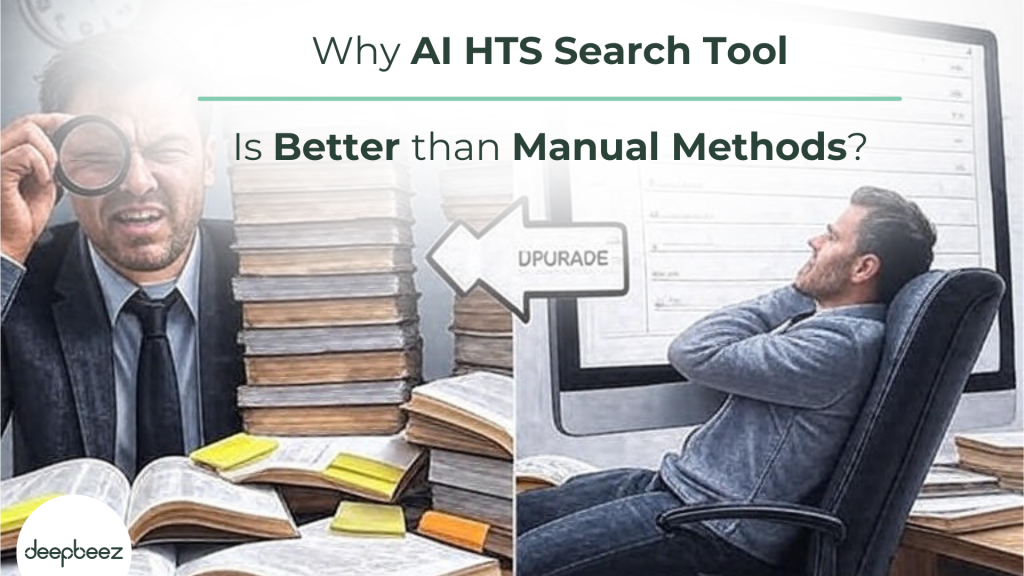Are you losing money on every shipment because you can’t find the right HTS code? Or worse – have you ever watched your goods sit in customs limbo while penalties pile up? These are just small challenges that you’ll face, if you don’t start using AI HTS Search Tool today! Try AI HTS code lookup for free and you will be amazed by the result.
The 5 Old-Fashioned Methods to Find Your HTS Codes
HTS codes (Harmonized Tariff Schedule codes) determine exactly how much duty you’ll pay on your imported products in the United States. The right HTS code can save you thousands of dollars per shipment, while the wrong one can cost you even more in penalties and delays. Remember that after finding the correct HTS code for your product, you need to prepare the documents required for import customs clearance in America.

Method 1: Ask Your Supplier
Your supplier exports products worldwide every day. They include HS or HTS codes on their export records for every shipment. Why not tap into this goldmine of experience? However, the code may be wrong or inappropriate.
Here’s how to approach your supplier:
- Ask them to confirm a code you’re considering
- Request their suggestion for the lowest compliant duty rate
- Get recommendations from multiple suppliers for the same product
Pro tip: Experienced suppliers often know which codes minimize duty while keeping you compliant. Don’t hesitate to ask – they want your business to succeed.
Discover more: Customs Tariff Number; Definition, Types and Examples
Method 2: Google It!
Google has become a fantastic resource for HTS code research. The search engine often gets it right when you combine your product name with “HTS code.”
Try these search strategies:
- “[Your product name] HTS code”
- “[Product category] harmonized tariff schedule”
- “[Specific product] import duty code”
But remember: Always verify Google results with official sources. Use this method as your starting point, not your final answer.
Method 3: Verify with the Official HTS Website
The official US HTS website (hts.usitc.gov) serves as your ultimate verification tool. However, we’ll be honest – the search function leaves much to be desired.
Here’s the smart way to use this site:
| Don’t Do This | Do This Instead |
| Search for “blue light blocking glasses” | Use the first 4 digits from your supplier/Google search |
| Rely on product name searches | Navigate through the code hierarchy |
| Ignore duty percentages | Check duty rates and country-specific exemptions |
Navigation tip: What is HTSUS? HTS codes follow a logical structure:
- First 2 digits = Chapter
- Next 2 digits = Heading
- Remaining digits = Subheadings
Tweaking these numbers helps you explore related categories and find the most accurate classification.
Method 4: Double-Check with Your Freight Forwarder
Your freight forwarder clears goods through customs every day. Good freight forwarders employ customs clearance experts who can:
- Confirm if your proposed code is correct
- Suggest better codes for lower duty rates
- Warn you about risky codes that might trigger seizures
Ask your freight forwarder these questions:
- “Does this HTS code look correct for our product?”
- “Can you suggest a better code for lower duty?”
- “What risks do you see with this classification?”
Method 5: Research Your Competitors’ Import Records
Want to know a secret? You can often discover what HTS codes your competitors use through tools like Jungle Scout’s supplier database.
Here’s how it works:
- Find your competitor’s product (like an Amazon ASIN)
- Look up their import records
- Check which HTS codes they used
- Compare their duty rates with yours
How AI Is Revolutionizing HTS Code Classification
Technology is transforming how we find and verify HTS codes. Let’s explore how AI can supercharge your classification process. These are the key AI technologies in HTS classification. If you are still unsure about using AI HTS code lookup tool, you can try it for free here.
| Technology | How It Helps | Real-World Application |
| Machine Learning (ML) | Learns from previous classifications to predict new codes | Identifies patterns across thousands of similar products |
| Natural Language Processing (NLP) | Extracts features from product descriptions | Understands context and product characteristics from text |
| Image Recognition | Analyzes visual product features | Classifies based on what the product actually looks like |
What Are Some Real-World Classification Challenges
Let’s look at a perfect example that shows why HTS classification requires expertise. Imagine you need to classify an elephant for customs purposes.
The Challenge: Two identical elephants require different HTS codes based on context:
- Elephant #1: A live animal in a zoo → Classified as “live animal mammal, other“
- Elephant #2: A circus elephant → Classified under “traveling circus or traveling menagerie“
How do you know the difference? You check the chapter notes. The live animal chapter excludes animals of heading 9508. When you look up heading 9508, you find it covers circus and traveling menagerie animals, including auxiliary equipment.
This example perfectly shows why human expertise remains crucial, even with AI assistance.
